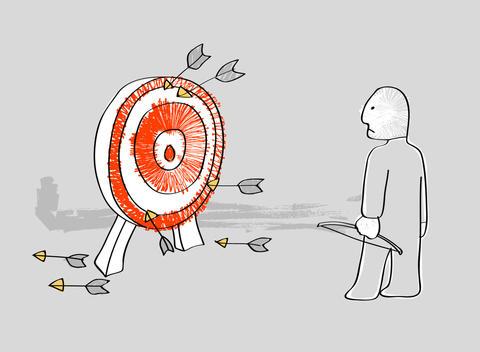
▲(Source of picture:http://polwig.com)
You looked at yourself in the mirror on January 1st, beginning to make a list of new year resolutions such as shake off 3 kg (and even bought a new pair of running shoes for it), life is supposed to unfold as the way you planned. Everything seemed so wonderful in your imagination!
January 2nd, your only exercise was lying on the couch, your new running shoes never touched the road.
This is a common scene in the beginning of the year. The new beginning motivates us but we are also easily be defeated due to lack of will power. Brand Keys, a market research institute did and survey and found out 75% of people will work hard to carry out their plans in the first week, 64% people could last over a month, before the summer comes, less than half of them could maintain their new year resolutions! It is a vicious circle where you make up your mind, give up then make up your mind again till you eventually fail. Perhaps you could blame it on the irrational mind but from economics point of view, people prefer to see fast result. They’d take the benefit presented right in front of them and give up the much handsome reward in the long run. This is the economic term, “quasi-hyperbolic discounting.”
Therefore, things that people need to pay the cost first and reap the gain much later could often lead the perception of being over-optimistic about the future. People like to postpone things to tomorrow, for example, compared to the slim figure they might have 3 months from now, they’d rather get a big bite on that hamburger now!
Give yourself some restraints
Establish “Promise mechanism” might be a way of resolving this. According to a report from the Economist, in Philippine, people who wish to quick smoking could sing the “Promise Contract.” Contract signer must conduct obligatory deposit in their bank account with zero interest. After 6 months, if they pass the Nicotine test, they could get their money back or else the money will be donated to charity organizations. This kind of contract enables the success rate for quitting cigarettes to increase over 30%.
The author of “Your life just lacks design,” Nagumo Haruyosh provided the perspective of design to resolve the New Year resolution dilemma. He thinks that the nature of design is to solve problem. Rather than thinking about how to resolve the problem, you should probably exam the “root” of the problem.
For example, if you wish to “never get constipated”, you need to design to simply your problem. Find out various reasons for constipation, such as pressure, lack of fruits and vegetables etc. Then you find coping methods to these reasons and establish a daily ritual around it. This is how to fulfill your wish through design!
The Secret of 21 Days
After you find the solution to your problem, the hardest part is to keep doing it. American psychologist Karl Lashley found out that if you repeat a new behavior for at least 21 days, it will become a habit. Therefore, to establish a new habit, you need to find ways to keep yourself repeating it until it becomes a habit.
In this sense, it’s best that you tell the world about your new year resolutions like posting your progress on social websites, so your friends and family could keep an eye on you. Or, you could quantify your wish so it becomes something measurable and executable. For example, if you want to have a fabulous figure, then your goal is to jog 30 minutes a day. Keep progressing day by day and give yourself some motivation and incentive to finish the set goals!
Whether the world would come to an end like the Mayan Prophecy, 2012 marks a new start. Say goodbye to your old habits and put yourself in the new rules!
List of Least “Realizable” New Year Resolutions

▲(Source of picture: http://transformnation.com/)
• Lose weight and maintain a good figure
• Quit smoking
• Learn new things
• Eat healthier and go on a diet
• Get rid of debt and save money
• Spend more time with family
• Travel in new places
• Experience less pressure
• Volunteer
• Drink less (alcohol)
Source of information: Time
